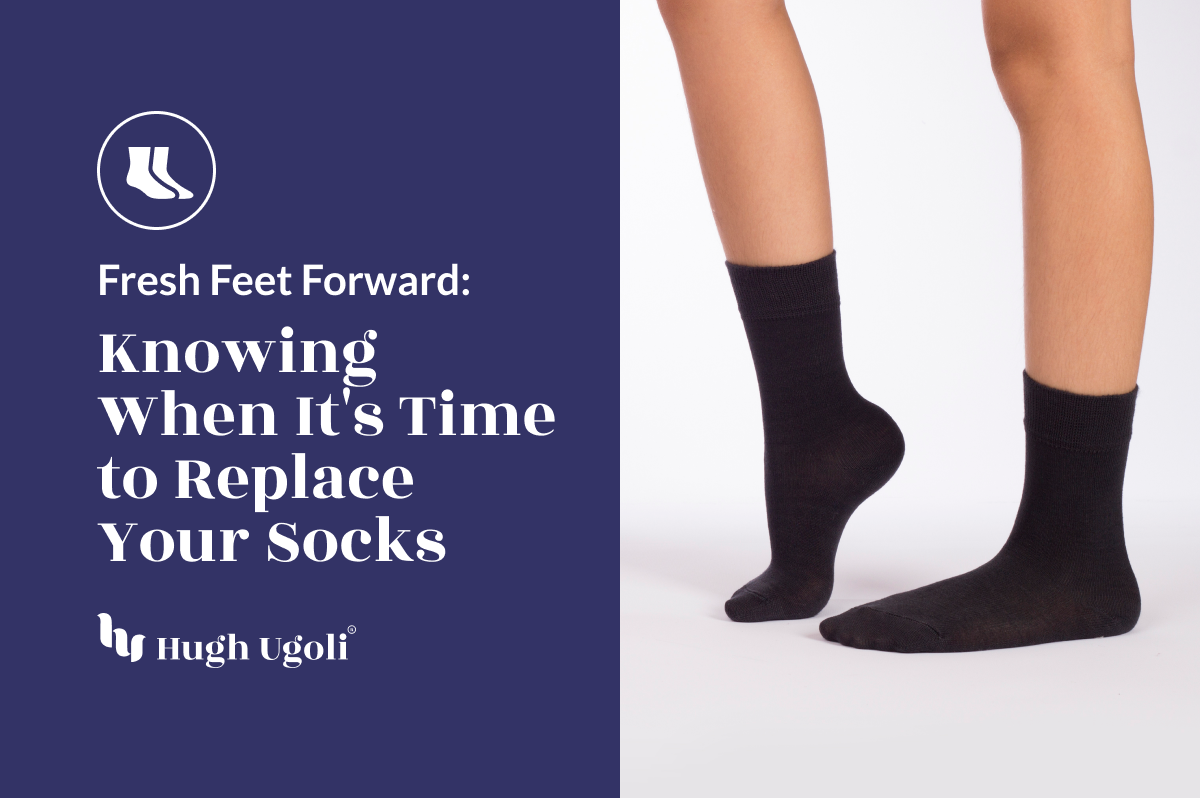Socks are the silent guardians of our feet, often overlooked yet vital for our daily comfort and foot health. But even these unsung heroes have an expiration date. Knowing when to retire an old pair can be the difference between happy feet and many foot problems. Let's step into the world of socks, unravel the signs of wear, and learn when it's time to refresh our sock drawers for the sake of our soles.
The Importance of Sock Health
Wearing socks past their prime is more than just dealing with a few holes or a less-than-perfect appearance. It's a health concern that deserves attention. Socks in good condition play a crucial role in absorbing sweat, reducing friction, and preventing blisters. When they begin to deteriorate, they lose these protective qualities, potentially exposing your feet to a range of issues from minor discomfort to infections.
Why Worn-Out Socks Are More Than Just a Fashion Faux Pas
Old, worn-out socks can compromise your feet's health in several ways. They no longer provide adequate cushioning, which can lead to increased pressure and impact on your soles with every step you take. The diminished protection can also make your feet susceptible to blisters, calluses, and rough patches.
The Impact of Socks on Foot Comfort and Hygiene
Fresh socks are essential for maintaining foot hygiene. They absorb moisture, keeping your feet dry and less hospitable to bacteria and fungi, which thrive in damp environments. Moreover, well-fitted, intact socks help prevent foot odor and provide a clean, comfortable barrier between your skin and your shoes.
Maintaining sock health is as important as choosing the right shoes. It's a simple yet effective way to care for your feet, ensuring they remain comfortable, dry, and protected throughout the day.

Signs of Sock Wear and Tear
Socks endure a lot, from the friction of a daily walk to the tumble of the wash. Over time, they show signs of wear that signal it's time for them to go. Recognizing these signs ensures you keep your feet encased in comfort and protection.
The Telltale Signs Your Socks Need Retiring
Keep an eye out for these clear indicators:
- Thinning Fabric: This is often the first sign. Check the heel and ball of the sock, where the fabric may look stretched and worn.
- Elasticity Loss: If your socks start to sag or fall, it's a sign the elastic is giving out, and they're no longer providing the snug fit necessary to prevent blisters.
- Holes and Tears: Even small holes can quickly become more significant problems, exposing skin to rough shoe interiors and increasing the risk of blisters and sores.
- Fading Color: While not a direct indicator of function loss, fading color can suggest the material is getting old and may start to compromise on comfort and protection.
The Hidden Dangers of Ignoring Worn Socks
Wearing socks with compromised integrity can lead to more than just discomfort. It can cause skin irritation, worsen foot conditions, and even lead to fungal infections like athlete's foot. The risks increase if you have diabetes or other conditions that make you prone to foot issues.
By staying vigilant and replacing your socks at the first signs of wear and tear, you maintain a healthy environment for your feet, keeping them in top condition to carry you forward.
Sock Replacement Frequency
The lifespan of a sock varies, but it's not indefinite. Regular assessment and timely replacement ensure your feet stay in peak condition.
How Often Should You Replace Your Socks?
There's no one-size-fits-all timeline, but a good rule of thumb is to observe your socks' condition every few months. For those who are active or wear the same few pairs regularly, it might be necessary to replace socks every three to six months. If you rotate among many teams, this frequency could decrease.
Variables Affecting Sock Longevity
Several factors can influence how long your socks last:
- Material: High-quality materials like merino wool or specialized synthetics last longer than standard cotton.
- Activity Level: More active lifestyles or sports-related use can accelerate wear.
- Care: Proper washing and drying can extend the life of your socks. Avoiding high heat and harsh detergents can prevent fabric breakdown and elasticity loss.
- Footwear: Rough interior shoe surfaces can cause quicker wear of socks.
By understanding these variables, you can better predict when to replace your socks and keep your feet stepping fresh.
Making Your Socks Last
While socks have a natural wear cycle, you can take steps to extend their serviceable life. Proper care and attention can keep your socks strong and your feet happy for longer.
Tips for Extending the Life of Your Socks
- Wash with Care: Turn your socks inside before washing to reduce pilling. Use gentle cycles and cool water to preserve the fabric and elasticity.
- Dry Thoughtfully: Avoid high heat in the dryer. Instead, air-dry your socks when possible to prevent shrinkage and maintain their shape.
- Rotate Regularly: Don't overburden a few pairs. Rotate through your sock drawer to distribute wear evenly across all teams.
- Trim Toenails: Keep your toenails trimmed and smooth. Sharp edges can snag and tear the fabric of your socks.
Sustainable Practices in Sock Usage
- Repair Minor Damage: Small holes can often be darned, giving your favorite socks a new lease on life.
- Recycle: When socks are past wearing, consider recycling them. Some brands take back worn socks for recycling, or you can repurpose them for household cleaning rags.
- Buy Quality: Investing in high-quality socks with durable materials can save you money in the long run, as they will only need replacing sometimes.
By adopting these practices, you make the most of every pair of socks and contribute to a more sustainable lifestyle.
The Right Time to Buy New Socks
Deciding when to invest in new socks is an art that balances keen observation with an understanding of sock health. It's time to hit the stores when you notice the cushioning in your socks isn't bouncing back, the colors have faded beyond recognition, or the fabric feels stiff and less breathable. These are all signs that your socks have served their purpose and are ready to retire.
Refreshing Your Sock Drawer: A Step-by-Step Guide
Begin by sorting through your current collection. Feel each pair for thickness, check for any signs of wear, and pay attention to how they fit. Socks that have lost shape or no longer stay up must go. Once you've identified the socks past their prime, note what you're discarding so you can replace any essentials.
Choosing Quality Over Quantity
When shopping for new socks, prioritize quality. Look for socks with reinforced heels and toes, which are the most worn. Consider the blend of materials and choose those that offer moisture-wicking properties to keep your feet dry. Remember, a few pairs of durable, comfortable socks are better than a drawer full of options that need to meet the mark.
By being proactive about sock replacement, you ensure your feet are always stepping into comfort and style. New socks can invigorate not only your feet but also your overall sense of well-being as you go about your day.
In the grand tapestry of personal care, the humble sock often goes unnoticed until it fails us. Recognizing the right time to replace your socks is a commitment to comfort, health, and hygiene. It's about understanding the subtle cues that your faithful foot companions are ready to bow out.
When the fabric thins, the elasticity wanes, or the comfort diminishes, take it as a sign to refresh your stock. Embrace the change as an opportunity to step into a new level of comfort with a fresh pair of socks that will confidently carry you forward. Keep your feet happy, and they will take you to great places.
















